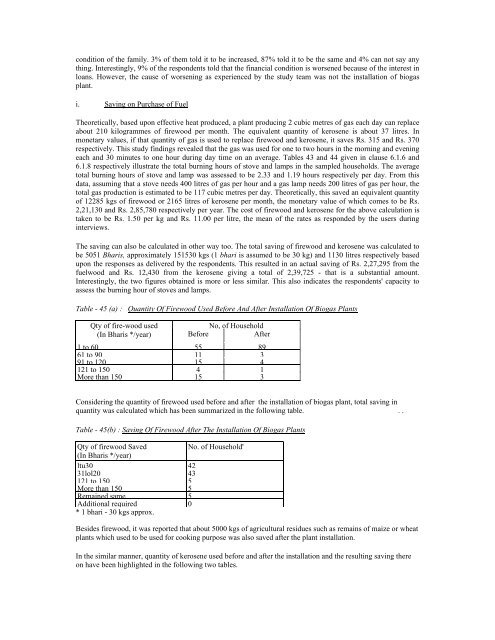download (pdf, 11MB) - SNV
download (pdf, 11MB) - SNV
download (pdf, 11MB) - SNV
You also want an ePaper? Increase the reach of your titles
YUMPU automatically turns print PDFs into web optimized ePapers that Google loves.
condition of the family. 3% of them told it to be increased, 87% told it to be the same and 4% can not say any<br />
thing. Interestingly, 9% of the respondents told that the financial condition is worsened because of the interest in<br />
loans. However, the cause of worsening as experienced by the study team was not the installation of biogas<br />
plant.<br />
i. Saving on Purchase of Fuel<br />
Theoretically, based upon effective heat produced, a plant producing 2 cubic metres of gas each day can replace<br />
about 210 kilogrammes of firewood per month. The equivalent quantity of kerosene is about 37 litres. In<br />
monetary values, if that quantity of gas is used to replace firewood and kerosene, it saves Rs. 315 and Rs. 370<br />
respectively. This study findings revealed that the gas was used for one to two hours in the morning and evening<br />
each and 30 minutes to one hour during day time on an average. Tables 43 and 44 given in clause 6.1.6 and<br />
6.1.8 respectively illustrate the total burning hours of stove and lamps in the sampled households. The average<br />
total burning hours of stove and lamp was assessed to be 2.33 and 1.19 hours respectively per day. From this<br />
data, assuming that a stove needs 400 litres of gas per hour and a gas lamp needs 200 litres of gas per hour, the<br />
total gas production is estimated to be 117 cubic metres per day. Theoretically, this saved an equivalent quantity<br />
of 12285 kgs of firewood or 2165 litres of kerosene per month, the monetary value of which comes to be Rs.<br />
2,21,130 and Rs. 2,85,780 respectively per year. The cost of firewood and kerosene for the above calculation is<br />
taken to be Rs. 1.50 per kg and Rs. 11.00 per litre, the mean of the rates as responded by the users during<br />
interviews.<br />
The saving can also be calculated in other way too. The total saving of firewood and kerosene was calculated to<br />
be 5051 Bharis, approximately 151530 kgs (1 bhari is assumed to be 30 kg) and 1130 litres respectively based<br />
upon the responses as delivered by the respondents. This resulted in an actual saving of Rs. 2,27,295 from the<br />
fuelwood and Rs. 12,430 from the kerosene giving a total of 2,39,725 - that is a substantial amount.<br />
Interestingly, the two figures obtained is more or less similar. This also indicates the respondents' capacity to<br />
assess the burning hour of stoves and lamps.<br />
Table - 45 (a) : Quantity Of Firewood Used Before And After Installation Of Biogas Plants<br />
Qty of fire-wood used<br />
No, of Household<br />
(In Bharis */year) Before After<br />
1 to 60 55 89<br />
61 to 90 11 3<br />
91 to 120 15 4<br />
121to150 4 1<br />
More than 150 15 3<br />
Considering the quantity of firewood used before and after the installation of biogas plant, total saving in<br />
quantity was calculated which has been summarized in the following table. . .<br />
Table - 45(b) : Saving Of Firewood After The Installation Of Biogas Plants<br />
Qty of firewood Saved<br />
No. of Household'<br />
(In Bharis */year)<br />
ltu30 42<br />
31lol20 43<br />
121to150<br />
More than 150<br />
5<br />
5<br />
Remained same 5<br />
Additional required 0<br />
* 1 bhari - 30 kgs approx.<br />
Besides firewood, it was reported that about 5000 kgs of agricultural residues such as remains of maize or wheat<br />
plants which used to be used for cooking purpose was also saved after the plant installation.<br />
In the similar manner, quantity of kerosene used before and after the installation and the resulting saving there<br />
on have been highlighted in the following two tables.
















